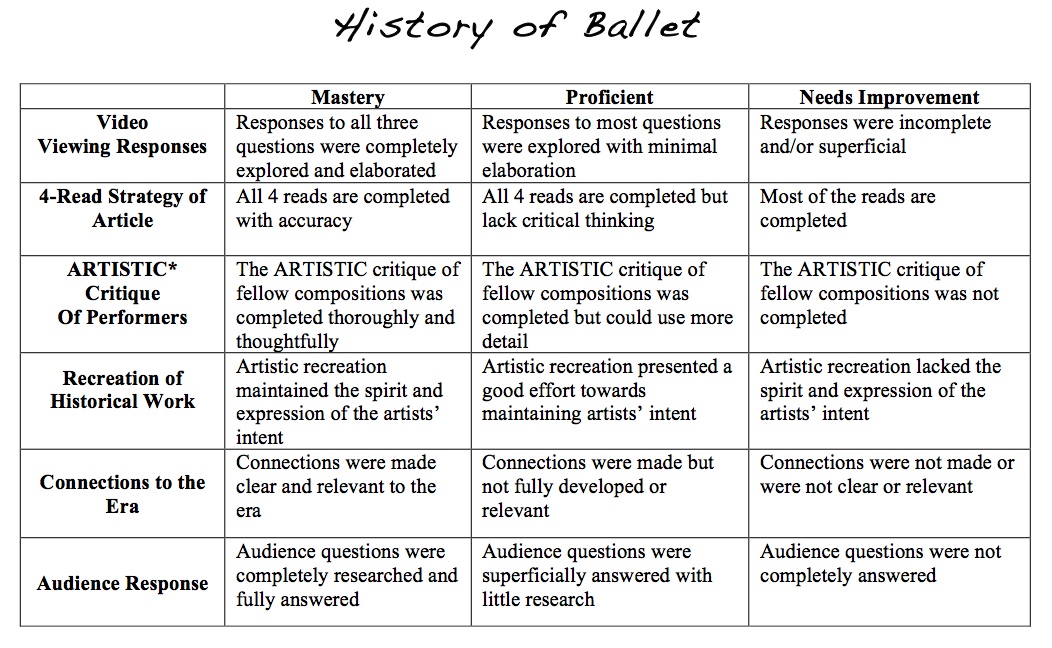Supporting History Class through the History of Dance: Part I
4 Min Read • Dance
Teaching history and theory of dance within our dance classes is so important. However, with the multitude of things we need to complete, how do we fit it in and how do we determine what is most important to teach? History is a part of us all and I’m all for support history class in our schools.
In this three part series, I will be sharing full lesson plans with interactive assessments for the history of Ballet, Jazz, and Modern that can be used immediately. These plans take roughly a week to complete so the students get an opportunity to learn about the history without taking too much time from the practicum of the studio environment.
Part I: History of Ballet
Lesson Plan
Grade: 9-12 (but can be simplified for younger students)
Title: A Brief History of Ballet
Anchor Standard 11: Relate artistic ideas and works with societal, cultural, and historical context to deepen understanding
Established Goals:
a. Analyze and discuss dances from selected genres or styles and/or historical time periods, and formulate reasons for the similarities and differences between them in relation to the ideas and perspectives of the peoples from which the dances originate
Enduring Understanding: Dance literacy includes deep knowledge and perspectives about societal, cultural, historical, and community contexts
Essential Question: How does knowing about societal, cultural historical and community experiences expand dance literacy
Objectives: Students will
- Complete a 4-Read of a brief history of Ballet
- View multiple pieces from the history of Ballet
- Research the time period being studied in History class
- Identify a classical piece that was created at that time
- Recreate a classical piece
- Connect the Ballet to the social/cultural issues of that time
Learning Activities
- Complete a 4-Read strategy on the following article from CBC News Online (2004), Into a fantasy world: A history of ballet. This is a very brief article on the history of Ballet, if time allows you can add additional articles for a more comprehensive look at Ballet.
- If reading during class, the following videos can be shown throughout the reading as each piece is addressed. If students are reading at home, take a class period to review videos. Search the following pieces online, and show then intermittently throughout the reading so students have a reference point. These pieces have been chosen specifically because they are mentioned in the article.
- Le Ballet Comique de la Reine
- La Sylphide
- Giselle
- The Sleeping Beauty
- Coppella
- Swan Lake
- Petrouchka
- Feel free to add to this list, or present some more contemporary pieces for comparison. Choose small clips of each piece just for students to gain some understanding of ballet of each era.
- During the viewing, have students make notes on what they see (adjectives/verbs), what emotions are evoked, reflections on what they like and dislike about the piece, and any connections they can make to what they are currently studying in history and in your studio classes.
- Separate students into groups of 2-3 (preferably with students who have the same history class, or are studying the same era in history) and have them complete the following tasks:
- Research the time period you are studying in history class through your notes, book, and/or internet searches.
- Identify the social and cultural issues occurring at that time.
- Search for Ballets that were created at that time.
- Once the reading and videos are complete, separate the class into groups of 2-3 (ideally, group students who have the same history class, or who are studying the same thing in history class). Within each group, have them complete the following tasks:
- Choose one ballet of that era to study and recreate.
- Watch the full ballet and make connections to the storyline, plot, conflicts, etc. to the historical (political and social) issues of that time.
- Choose 1-2 minutes of the ballet to recreate and present (this can alter based on your students needs and skill level).
- Begin preparing the presentation.
- Have students present by first discussing the background of the piece, and the connections to the era. Next performing the section of movement. Finally, soliciting further questions to be researched from the audience.
- As students are watching, they should be completing two tasks:
- Utilizing ARTISTIC critique to evaluate the recreations. Since it is not a full recreation, nor an original piece, focus on A-R-T of the critique.
- Second, have them write down further questions for research on an index card. At the culmination of the presentation, have the presenters collect the cards and respond to them. Have them return the cards with answers, after you have evaluated the question and answer.
- Use the following questions as discussion or final assessment:
- Defend the following statement: Ballet is a deception.
- Compare Marie Salle to Marie Camargo and infer who would be the most accepted by the society of her era, why?
- Which of the Marie’s (Camargo, Salle, Taglioni) would support the 19th century ballet costuming, why?
- How has Rudolph von Labon influences contemporary (current) dance?
Unit Rubric

Resources
Ballet Article
4-Read Strategy
ARTISTIC CritiqueUnit Rubric
This is the first of a three-part series on introducing history lessons of western genres into your studio classes. This can be extended or reduced based on time constraints.
Next Week: Teacher Evaluations



